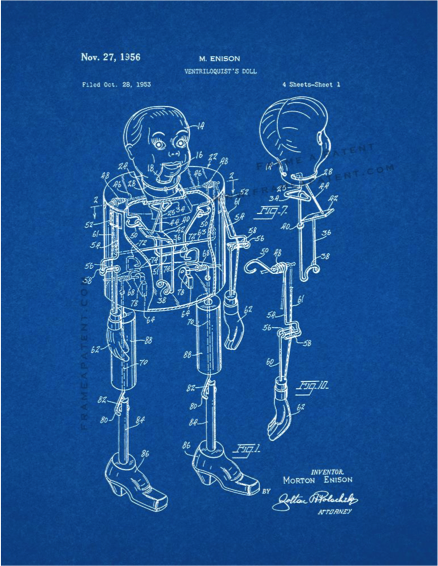A DELEUZIAN BLOB: ENGINEERING VENTRILOQUIST GEOMETRY

Episode 3: VENTRILOQUIST PHILOSOPHY: A PUPPET WITHOUT A MASTER Keywords: Non-Philosophy, artist/philosopher , affect-percept-concept
According Deleuze art and philosophy evoke different becomings. Art, as sensory becoming does not extract concepts but percepts and affects, to the contrary of philosophy, which consist of infinite conceptual becomings. A work of art is essentially a “bundle of affects”, affects on their turn are zones of indetermination emerging within becoming, becoming is not a transformation of one thing into another, but a space where “something passes from one to the other”. Every artist should take upon the role of inventor or creator of unknown or unrecognized affects, and the philosopher that of the extractor par excellence of concepts concealed throughout the affect repository. Undeniably there is a seepage or overlap between the two different becomings, but if we want to truly conjoin the planes together, how do we proceed? Or how does a artist/(philosopher) proceed? Does the artist/(philosopher) performs two sequential acts, first that of art, then that of philosophy, or do they occur simultaneously? If so, what does such an event entail and what are its conditions? The most simplistic solution would be the fusion of their idiosyncratic elements; a painting with a message, or philosophy illustrated where maybe contingent concept, percepts and affects could emerge, but this solution would render philosophy or art superficial. Myriad attempts preceded us in the reproduction of ‘new’ mixtures, so what would make this different? What we are looking for is the constitution of a consistent structure, a new syntax if you will, not a “philosophical appearance”. We commit to a compossibility of art and philosophy where the art-philosophical trinity – affect, percept and concept – is intrinsically entangled in the form and procedure of the amalgam that generates a special affect in philosophy. But isn’t this entanglement already embedded within Kant’s famous declaration that concepts without percepts are empty, and percepts without concept are blind, or are we in need of an addendum? If so, again, the direction to probe is that of Laruelle’s non-philosophical effects that appear on one surface as scientific representations and on the other as philosophical fictions for philosophy. These are “non-philosophical representations that are organized by new rules, therefore having specific effects, more exactly: hyperspeculative or extra-speculative effects.” Our attempt must adhere a similar cause but albeit different function. The philosophical (a)effect must perform a double role: one is an outward affect that functions as an intensifier or catalyst for conceptual understanding, the other an inward effect as a restructuring that must have a relevance to philosophy and present it in rearranged form. The question do the two effects occur simultaneously becomes irrelevant if the bi-directional effects are attained within the procedure. If effectively executed art speaks ‘in front of’ or ‘outside’ philosophy, not as metaphor – nor any other literary effect for that matter – but as an art-philosophical ventriloquism. But does art takes upon the role of the puppet with philosophy as its master, or does philosophy speaks with the hand of art stirring its guts? The hierarchy of master and puppet dissolves when it ‘speaks’ with the mind of a philosopher and the mouth of a performer, as the fooling we accept. But paramount is that the expression as event is convincing and authentic. It is not different with the concept expressed through the “bloc of affects and percepts” art is. It should express properly the concept’s workings, components, contours and dimensions. Deleuze himself speaks of the contour of the concept; a philosophical outlining that exposes the concept’s form through a matter of articulation, dissection and crosscutting. This is what an art-philosophical ventriloquism could enable when art speaks with philosophy. It does not proclaim, to the contrary of Laruelle, that it speaks predominantly ‘about’ philosophy – in scientific or any other manner – but actively seeks a humble and creative companionship with art. This can be a philo-fiction, but can also be the geometric method affectively performed. The ventriloquist act is in distinct separation with the concept of disguise, which is effectively a temporal suspension of an ontological position that is: it acts out a temporal appearance as the ‘other’ is or ought to be. What we are looking for is a new constitution where the idiosyncratic mechanisms are intrinsically linked, and in direct causal relation as a double Archimedean point: art enabling philosophy to lift off and vice versa. Why not? What if we create a syntax where the extraction of concept, percepts and affects are entangled? Affects are precisely the nonhuman becomings of man. Is the geometric method capable as a producer of affects and percepts? Creating a framework where contingent affections and percepts may arise. It is not digital art, nor mathematical illustration, but an attempt to fill in the void hiding underneath/inside the surface. It is pedagogical but also instigative. But aren’t exactly these mesmerizingly mixed when one properly ‘speaks’ in front of, or outside the other? If Deleuze himself speaks of the contour of the concept, a philosophical outlining that exposes the concept’s form through a matter of articulation, dissecting and cross-cutting, does it not initiated an affective exchange between subject and concept? And if so, can’t we intensify it further within the matrix of aesthetic qualities? Can we relate to a concept’s shape not only intuitively but geometrically as well? It is an expression of the concept (workings, components, ideas). But this expression needs a system – like a language – to repeat itself effectively, hence we create an aesthetic realm where it can become, but also exposes its history. As a character that passes through different dramatic becomings, from point it needs to repeat itself indefinitely to become a line… Great creative affects can link up diverge, within compounds of sensations that transform themselves, vibrate, couple or split apart. “